Genome-wide microarray-based analysis of miRNAs expression in patients with acute-onchronic liver failure
Wen Chen, Ze-Hui Yan, Yu-Ming Wang, Bao-Yan Xu and Guo-Hong Deng
Chongqing, China
Genome-wide microarray-based analysis of miRNAs expression in patients with acute-onchronic liver failure
Wen Chen, Ze-Hui Yan, Yu-Ming Wang, Bao-Yan Xu and Guo-Hong Deng
Chongqing, China
BACKGROUND:Acute-on-chronic liver failure (ACLF) is a severe clinical syndrome that may cause a high mortality. However, the mechanism is still not clear. Characterization of the microRNA (miRNA) profiles in ACLF patients may provide new clues to the pathogenesis and management of this syndrome.
METHODS:Genome-wide microarray was performed to compare the different miRNA expression profiles in peripheral blood mononuclear cells of a pair of monozygotic twins, an ACLF patient and an HBV asymptomatic carrier (AsC). The case-control miRNA profiles were compared and confirmed by quantitative reverse transcription-polymerase chain reaction in 104 ACLF patients and 96 AsCs. A combined computational prediction algorithm was used to predict the potential target genes.
RESULTS:Forty-five miRNAs were increased and eight miRNAs were decreased in the ACLF group. The expressions of hsa-let-7a and hsa-miR-16 were increased by 8.58- and 8.63-fold in ACLF patients compared with that in AsCs, respectively (P<0.001). CARD8, BCL2, IL1RAPL1, LTB, FZD10 and EDA were identified as the target genes of hsa-miR-16; MAP4K3, OPRM1, IGF2BP1 and CERCAM were verified as the target genes of hsa-let-7a.
CONCLUSIONS:Our results showed that there is a close relationship between specific miRNAs of peripheral blood mononuclear cells and ACLF. hsa-miR-16 and hsa-let-7a may contribute to the development of ACLF.
(Hepatobiliary Pancreat Dis Int 2014;13:32-39)
acute-on-chronic liver failure; microRNA;
microarray;
twins
Introduction
Hepatitis B virus (HBV) infection is reported to infect more than 350 million people worldwide and results in a broad spectrum of HBV-related liver diseases, including acute hepatitis, asymptomatic carrier (AsC), chronic hepatitis, liver failure, liver cirrhosis and hepatocellular carcinoma (HCC).[1, 2]Acute-on-chronic liver failure (ACLF) is a severe clinical syndrome characterized by severe liver dysfunction and hepatic encephalopathy that may cause a high mortality particularly in HBV-infected patients. It has been estimated that over five hundred thousand Chinese patients die from the HBV-related diseases per year.[3]Although advances in intensive care and medical management have improved the outcome, the prognosis of ACLF remains poor. The poor understanding of the pathophysiology of this complex event may contribute to this poor prognosis. So far the persistence of HBV DNA and antigen protein are widely recognized as the risk of chronicity and severity of chronic hepatitis B.[4]However, it has been recently shown that immunological status from the host plays an important role in progression and outcome of HBV-related diseases.[5, 6]Nevertheless, the rigor mechanisms modulating the immunological response are not yet fully elucidated.
Recently, microRNAs (miRNAs), a new regulatory class of non-protein-coding, single-stranded small RNAs, were attached importance to the immunological mechanisms. miRNAs have been characterized as pivotal posttranscriptional regulators of gene expression, which are believed to play important functions in normal physiology and disease development.[7, 8]Recent datahave shown that miRNAs participate in the mechanisms of chronic viral infections, and meanwhile are critical in modulating viral replication and controlling viral-host interactions.[9, 10]Accumulating data suggest that specific miRNAs may also regulate HBV replication and affect the progression of diseases.[11-14]It has been reported that there was a different miRNAs expression profiles in plasma of patients with chronic hepatitis B as compared with healthy controls.[15-17]For example, HBV infection is associated with increased expression of miRNA-122; the level of circulating miRNA-22 was paralleled with HBV replication and liver injury in HBV-infected patients.[18]Meanwhile, increasing data also clearly showed that miRNAs may play a key role in the immune system.[19, 20]There is a relationship between the specific circulating miRNAs and immunological stages in the natural course of this disease. Some specific miRNAs may contribute to the chronicity and aggravation of HBV-related diseases.[21]These data suggest that miRNAs may be new molecules involved in the progression and pathophysiology of HBV-related liver diseases.
To date, over thousands human miRNAs have been identified. Some miRNAs from multifarious organs and tissues circulate in the peripheral blood and have the possibility to act as diagnostic markers.[22]For example, miRNA-29a-5p may be a useful prediction marker in early cancer recurrence after HCC operation.[23]Some miRNAs may represent important targets for potential therapeutic agents,[24, 25]among which an oligomeric miRNA-122 complex has been used to treat patients infected with hepatitis C virus.[26]To our knowledge, the miRNAs expression profile in patients with ACLF has not yet to be reported.
Considering the significance of miRNAs in the pathophysiology of the HBV-related liver disease, we hypothesized that miRNAs may involve in the immunopathogenesis of HBV infection, and specifically miRNAs could be of importance in the development of ACLF. Characterization of the differentially expressed miRNAs between the group of ACLF and the controls may provide new clues to the pathogenesis and management of this syndrome. In this study, we pursued this hypothesis by screening the genome-wide miRNA expression profile in peripheral blood mononuclear cells (PBMCs) of a pair of monozygotic twins with ACLF and AsC, respectively. The expression profile of miRNA was then confirmed by quantitative real-time reverse transcription polymerase chain reaction (qRTPCR). Potential target genes for differentially regulated miRNAs were predicted by scouting the genome-wide mRNA expression used different algorithms such as TargetScan, Diana microT, PicTar, etc.[27]
Methods
Patients and controls
A pair of monozygotic twins with HBV infection who were admitted at Southwest Hospital (Chongqing, China) was recruited in this study. The twins were diagnosed with ACLF and AsC, respectively. The zygosity of the twins was detected by short tandem repeat (STR) microsatellite polymorphism analysis as we previously described.[28]Furthermore, between May 2008 and October 2011, 104 patients with ACLF and 96 AsCs were also recruited in the study. All patients with ACLF and AsC were positive for both HBsAg and antibody to HBV core antigen (HBcAb) of the IgG type for at least 12 months. ACLF was diagnosed as liver injury characterized by jaundice, coagulation abnormality [usually an international normalized ratio (INR) ≥1.5], and any degree of mental alteration (encephalopathy) in a patient with chronic liver diseases, according the criteria from the Diagnostic and Treatment Guidelines for Liver Failure.[29]AsC was diagnosed according to the published criteria.[30]The patients with any serologic evidence for co-infection with human immunodeficiency virus, hepatitis C virus or hepatitis D virus were excluded from this study. The carriers with hepatitis symptoms or cirrhosis evidences during the follow-up were also excluded from the AsC group.
The clinical characteristics of the two groups are shown in Table 1. All individuals provided written informed consent to participate in the study. This study was approved by the Ethical Committee of Southwest Hospital, Chongqing, China.
RNA extraction
Blood samples of all ACLF patients and AsCs werecollected in EDTA tubes according to the standard procedures. Human PBMCs were separated by density gradient centrifugation using Ficoll-Histopaque (Sigma, USA). Total RNA was isolated from the PBMCs of the pair of monozygotic twins, 104 ACLF patients and 96 AsCs respectively by Trizol reagent (Roche, USA) according to the manufacturer's protocol. RNA integrity was evaluated by 1% formaldehyde-agarose gel electrophoresis and the quality of the RNA samples was analyzed by the absorbance at 260A/280A ratio. RNA concentrations were determined using a NanoDrop 2000c spectrophometer (Thermo, Massachusetts, USA) by measuring absorbance at 260 nm. When the concentrations from extracted RNA samples were higher than 100 ng/μL and the 260A/280A ratio was higher than 1.8, the processed samples were stored at -75 ℃ until miRNA microarray analysis and qRT-PCR miRNA expression validated the analysis.
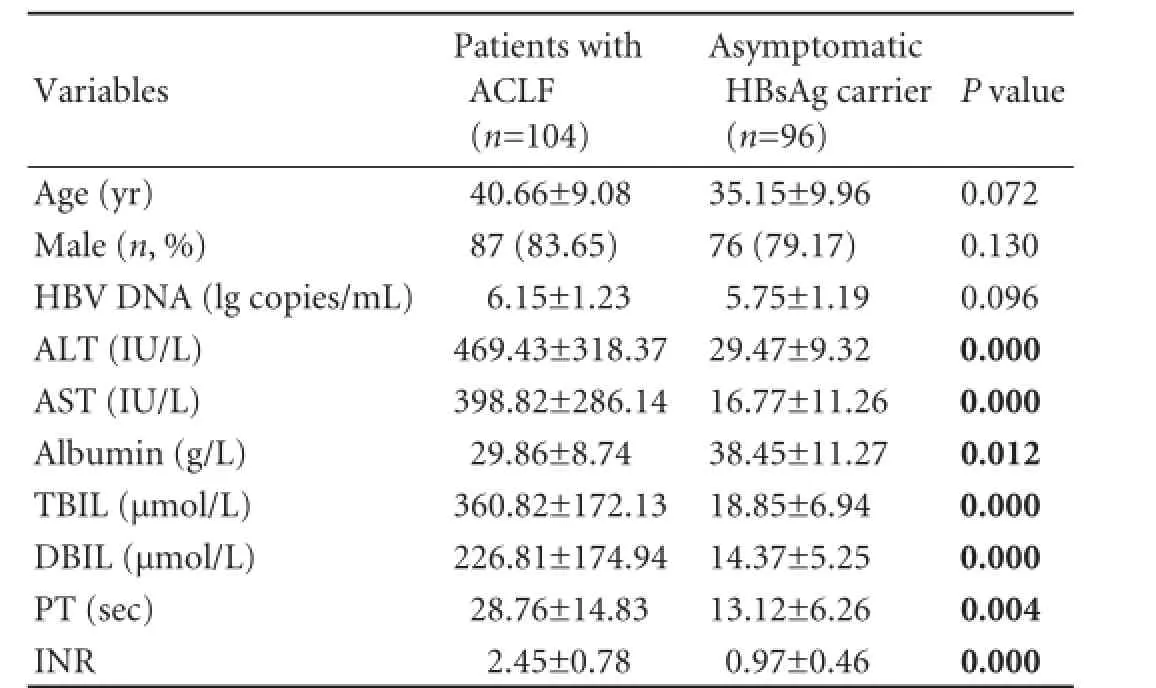
Table 1.The clinical characteristics of the two groups (mean±SD)
miRNA microarray analysis
The extracted total RNAs from the pair of monozygotic twins who were diagnosed with ACLF and AsC, respectively, were sent to Kangcheng Biological Engineering Co., Ltd. (Shanghai, China) for miRNA microarray analysis. Following validation, the quality of RNA samples, two micrograms of total RNA from each sample and from common reference pooled samples were labeled with Hy5? and Hy3 ? lf uorescence, respectively, using the miRCURY? Array Power Labeling kit (Cat #208032-A, Exiqon, Vedbaek, Denmark) following the procedure described by the manufacturer. The Hy5?-labeled samples and Hy3 ?-labeled reference RNA sample were mixed in pair wise and hybridized to the miRCURY? LNA Array (Exiqon version 8.1), which contains capture probes targeting all miRNAs for all species registered in the miRBASE. The hybridization experiments for each sample were performed twice using a Tecan HS4800 hybridization station (Tecan, Austria).
The miRCURY? LNA Array microarray slides were scanned using a GenePix4000B laser scanner. Images were quantified by the GenePix Pro 6.0. Each point is repeated four times and signal intensities for each spot were calculated by subtracting local background intensities from total intensities. Raw data were further processed in Microsoft Excel. The global locally weighted scatterplot smoothing regression algorithm was used to normalize the signal intensities. Analysis was made using the log2of the background-subtracted, normalized median spot intensities of ratios from the two channels. The median of Hy3/Hy5 intensity for replicative point for every miRNA was obtained after normalization. The difference in log2value for each miRNA was considered in subsequent analyses. A difference of more than 1.5 fold was considered statistically significant.
miRNA-specific qRT-PCR for miRNA
For validation of microarray data by qRT-PCR, cDNA was obtained from total RNA using miR-specificor endogenous control-specific reverse primers according to the NCode? SYBR? Green miRNA qRTPCR Kit (Invitrogen, USA). The total RNAs were firstly treated with poly(A) polymerase for 15 minutes at 37 ℃ with the mixture contained 4 μL RNA, 5 μL 5 × miRNA Reaction Buffer, 2.5 μL MgCl2(25 mmol/ L), 1 μL ATP (1:50), 0.5 μL poly(A)polymerase and 12 μL nuclease-free water (Exiqon). Poly(A)polymerase-treated total RNA was then reverse-transcribed to cDNA using SuperScript? III RT/RNaseOUT? Enzyme Mix. Each reverse transcription (RT) reaction contained 4 μL of poly(A)polymerase-treated RNA samples, 1 μL annealing buffer, 3 μL universal RT primer (25 μmol), 10 μL 2× fi rst-strand reaction mix, 2 μL SuperScript ? III RT/ RNaseOUT? Enzyme Mix*2 with a total volume of 20 μL. Reactions were incubated in a mastercycler gradient (Eppendorf, Hamburg, Germany) for 5 minutes at 65 ℃, 50 minutes at 50 ℃, followed by heat-inactivation of RT for 5 minutes at 85 ℃ and held at 37 ℃. qRT-PCR was performed using the ABI 7500 system (ABI, USA) with 50 μL PCR reaction mixture including 5 μL RT product (template), 25 μL SuperMix-UDG, 1 μL ROX reference dye, 1 μL forward primer (10 μmol/L), 1 μL universal qPCR primer, and 17 μL nuclease-free water. Reactions were incubated in a 96-well optical plate and the PCRs were programmed as follows: 50 ℃ for 2 minutes, 95 ℃ for 2 minutes, and then 15 seconds at 95 ℃ and 30 seconds at 60 ℃ for 40 cycles. RT and qRT-PCR primers are listed in Table 2. All reactions including negative controls were performed in triplicates. A standard housekeeping miRNA, miR-5S, were used as endogenous controls to normalize the expression of target miRNAs.Delta Ct values were used for the analysis. The relative amount of each miRNA to miR-5S was described using a 2-ΔΔCtmethod.[31]miRNA expression differences were evaluated by the nonparametric Mann-Whitney U test, and P values less than 0.05 was considered statistically significant.
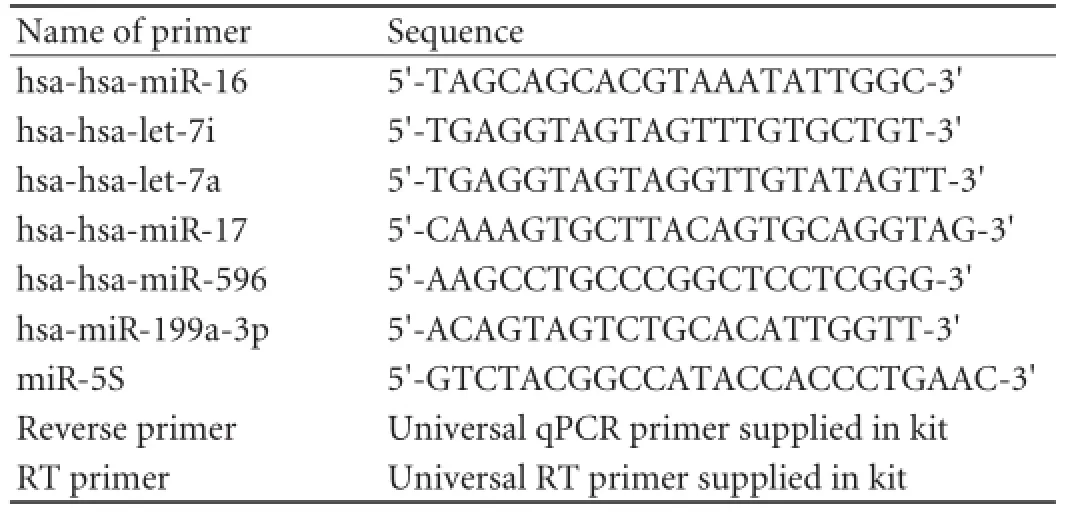
Table 2.The primers for qRT-PCR

Prediction of the potential target genes of miRNAs
Although many algorithms have been used to predict and analyze the target genes of selected miRNAs, there is no single algorithm that outperforms others in terms of sensitivity and specificity. Therefore, we predicted the potential targets of those down-regulated or upregulated miRNAs by the commonly used web tools for bioinformatic algorithms as described previously, including 3 of the most used prediction websites: TargetScan http://www.targetscan.org/, PicTar http:// pictar.bio.nyu.edu and miRanda http://www.microrna. org/, as well as two additional algorithms, RNA hybrid http://bibiserv.techfak.uni-bielefeld.de/rnahybrid/ and MirTarget2 http://mirdb.org/miRDB/. The genes which were identified in two or more methods were considered as potential target genes regulated by a given miRNA. UCSC and NCBI databases were used for functional analysis of those predicted genes.
Results
Data analysis of miRNA microarray
We successfully performed a genome-wide miRNA expression profiling in human PBMCs from a pair of monozygotic twins, who were diagnosed with ACLF and AsC, respectively. Statistical analysis of microarray spot intensities indicated satisfied reliability (P>0.05) and reproducibility (r2>0.95) from the duplicate assays. The heat maps (Fig. 1) generated by hierarchical clustering showed that the miRNAs were differently expressed between the controls and the pair of monozygotic twins with chronic HBV infection. Some miRNAs were expressed lower in the internal control (U6-SnRNA) and highly expressed in samples of the pair of monozygotic twin. Aberrated expression of miRNAs could also be different between the samples from the pair of monozygotic twins, which represented different clinical subtypes with chronic HBV infection. We successfully detected 677 miRNAs by miRNA microarray in both groups. Among them, 53 miRNAs were differentially expressed between the samples from the monozygotic twins. Of the 53 differentially expressed miRNAs, 45 miRNAs were up-regulated and 8 miRNAs downregulated in the patient with ACLF in comparison with his twin brother with AsC.
Validation of differently expressed miRNAs
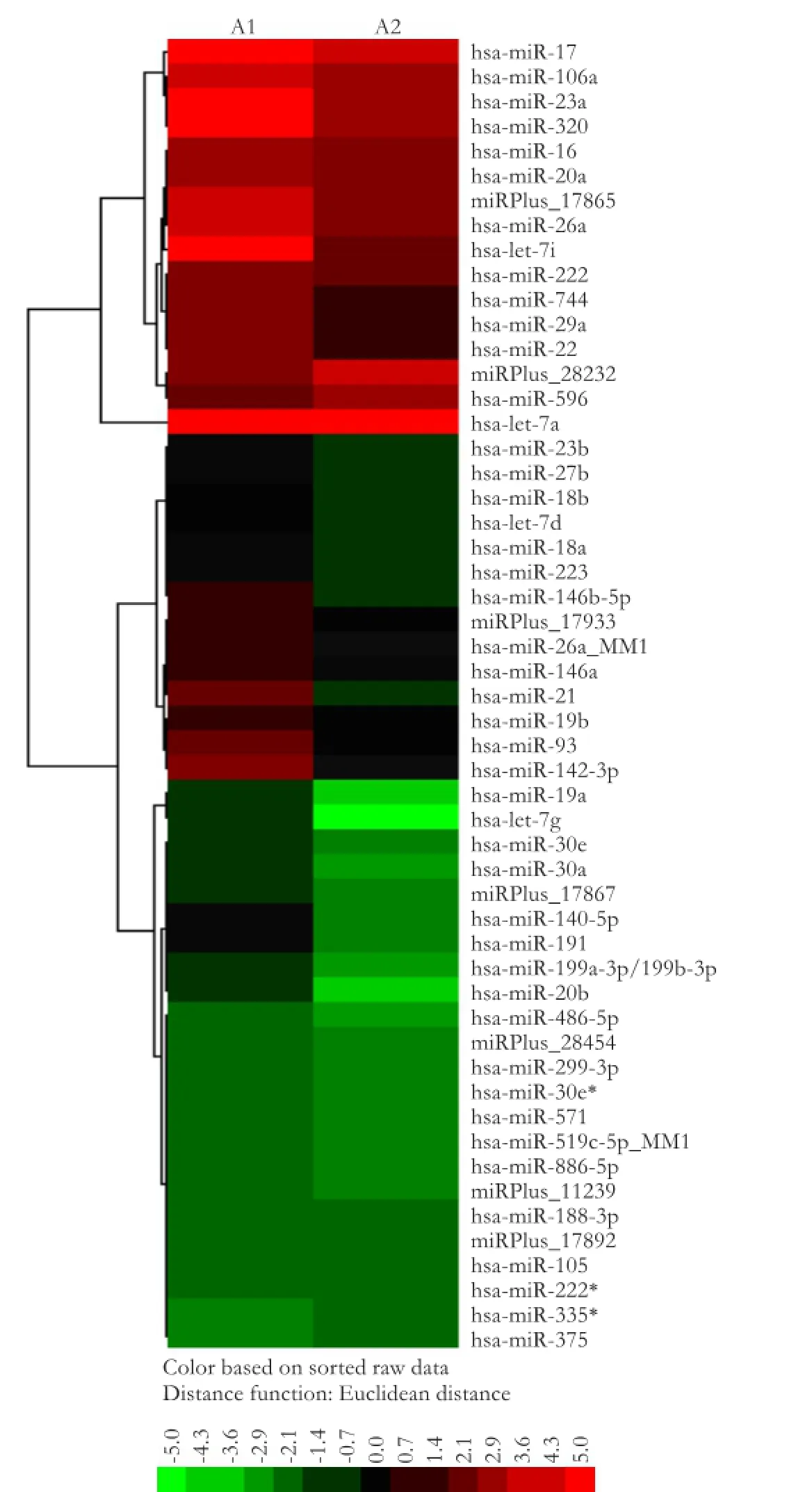
Fig. 1.The heat maps generated by hierarchical clustering. The differentially expressed miRNAs are between the control and the pair of monozygotic twin with chronic HBV infection. After normalization of the raw data, 677 miRNAs were detected in both groups, with 53 of them differentially expressed by miRNA microarray in which 45 miRNAs up-regulated and 8 miRNAs down-regulated in the patient with ACLF in comparison with his twin brother with asymptomatic HBsAg carrier.
To validate microarray results, we first analyzed qRT-PCR expression in the twin samples by microarray. Five up-regulated miRNAs (hsa-let-7a, hsa-let-7i, hsa-miR-16, hsa-miR-17 and hsa-miR-199a-3p) and one downregulated miRNAs (hsa-miR-596) in the patient with ACLF screened by the miRNA microarray were further quantified using the qRT-PCR method. As shown in the histogram (Fig. 2A), the relative fold changes in these miRNAs expressions as determined by qRT-PCR were similar to those determined by microarray analysis. The qRT-PCR for these selected miRNAs confirmed the results obtained by the microarray analysis.
Since the miRNA microarray was only performed in the PBMCs of a pair of monozygotic twins, we confirmed the microarray results in a large hospitalbased case-control cohort, including 104 cases of ACLF and 96 AsC controls. The miRNA expressions of the 4 selected up-regulated miRNAs, hsa-let-7a, hsa-let-7i, hsa-miR-16 and hsa-miR-17, in the case-control cohort were quantified by qRT-PCR. As illustrated in the histogram (Fig. 2B), the expression levels of miRNA hsalet-7a and hsa-miR-16 were significantly higher in the cases of ACLF compared with those in AsC. The relative fold changes in the miRNAs expression of hsa-let-7a and hsa-miR-16 were 8.58-fold and 8.63-fold, respectively. However, the expressions of miRNA hsa-let-7i and hsamiR-17 were not significantly different between the two groups.
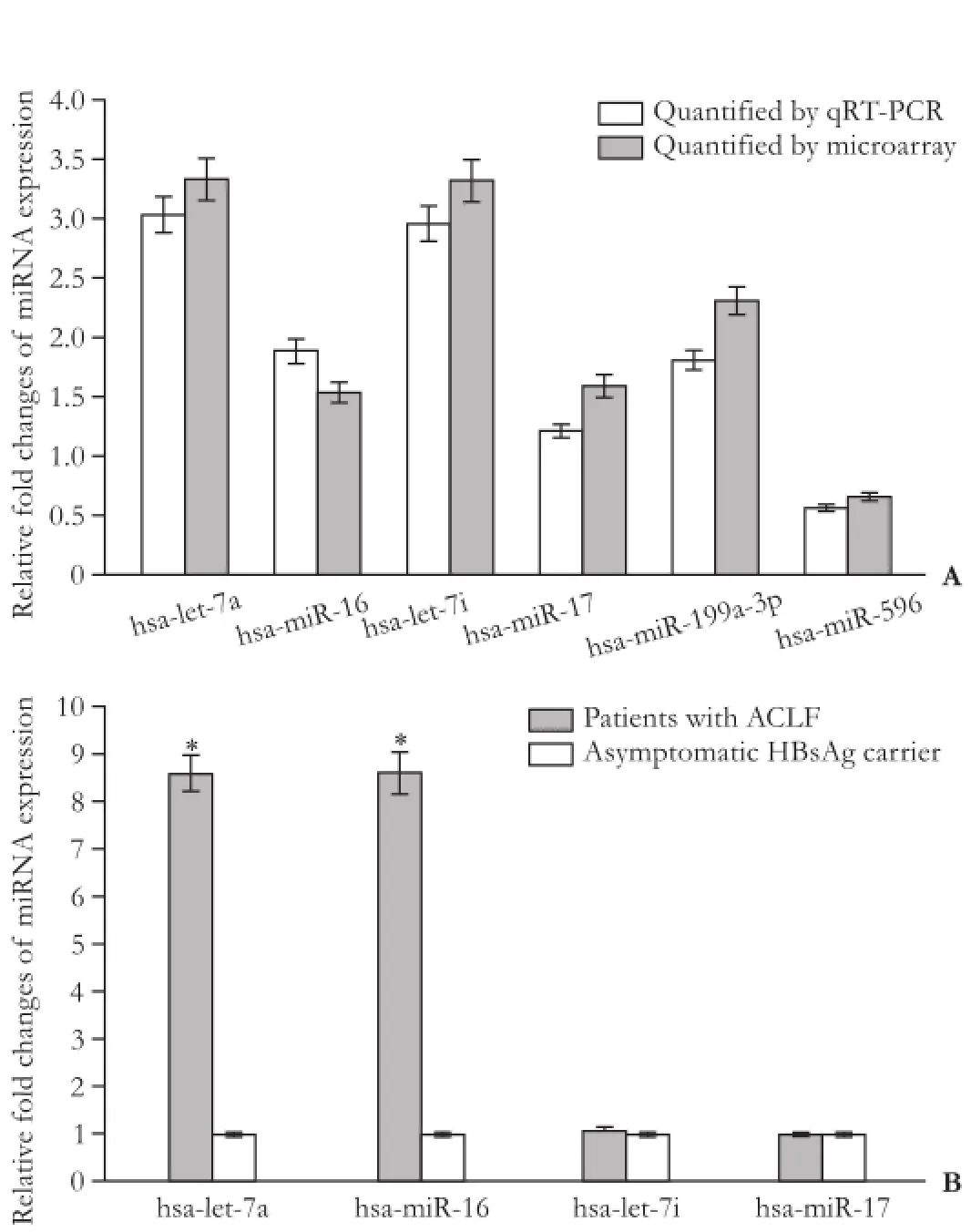
Fig. 2.Validation of differentially expressed miRNAs.A: The relative fold changes of miRNA expression (ACLF/AsC) in the twin samples quantified by two different quantitative methods. Six commonly changed miRNAs are listed on the X-axis, and the Y-axis refers to relative fold changes of miRNA expression (ACLF/ AsC). Blank and grey bars refer to relative fold changes of miRNA expression (ACLF/AsC) quantified by qRT-PCR and microarray, respectively. Column, mean of triplicate measurements; bar, SD. Comparison is between the relative fold changes of miRNA expression (ACLF/AsC) quanlified by qRT-PCR and that quanlified by microarray;B: The relative fold changes of miRNA expression quantified by qRT-PCR in a large hospital-based casecontrol cohort including 104 patients with ACLF and 96 AsC controls. miRNA expression between the ACLF patients and AsCs were validated by qRT-PCR. Four miRNAs are listed on the X-axis, and the Y-axis refers to the relative fold changes of miRNA expression (ACLF/AsC) quantified by qRT-PCR. Blank bars refer to the relative fold changes of miRNA expression in AsCs which were normalized to value 1, and grey bars refer to the relative fold changes of miRNA expression in ACLF patients. Column, mean of triplicate measurements; error bar, SD. Comparison is between ACLF patients and AsCs. *: P<0.05.
Target analysis
We analyzed the predicted targets of the most significantly up-regulated miRNAs: hsa-let-7a and hsamiR-16, both were validated differentially expressed miRNAs. The analysis was made using the ensemble algorithms, miRanda, PicTar, TargetScan, MirTarget2,and RNA hybrid, to predict human miRNA gene targets. To determine whether hsa-let-7a and hsa-miR-16 were directly involved in the pathophysiology of ACLF, a miRNA/target gene/biological function linkage analysis was performed in silicon using the PicTar algorithm for the prediction of miRNA targets. Our analysis suggested that B cell lymphoma-2 (BCL2), caspase-associated recruitment domain 8 (CARD8), ectodysplasin-A (EDA), interleukin 1 receptor accessory protein-like 1 (IL1RAPL1), lymphotoxin beta (LTB), and frizzled family receptor 10 (FZD10) gene may be the putative target genes of the miRNA hsa-miR-16, while cerebral endothelial cell adhesion molecule (CERCAM), insulinlike growth factor 2 mRNA binding protein 1 (IGF2BP1), opioid receptor mu 1 (OPRM1), and mitogen-activated protein kinase 3 (MAP4K3) genes may be the putative target genes of the miRNA hsa-let-7a. As shown in Table 3, all of these putative target genes function as important molecules in the hepatic inflammation, metabolism, and immunology and play key roles in the pathology of ACLF.
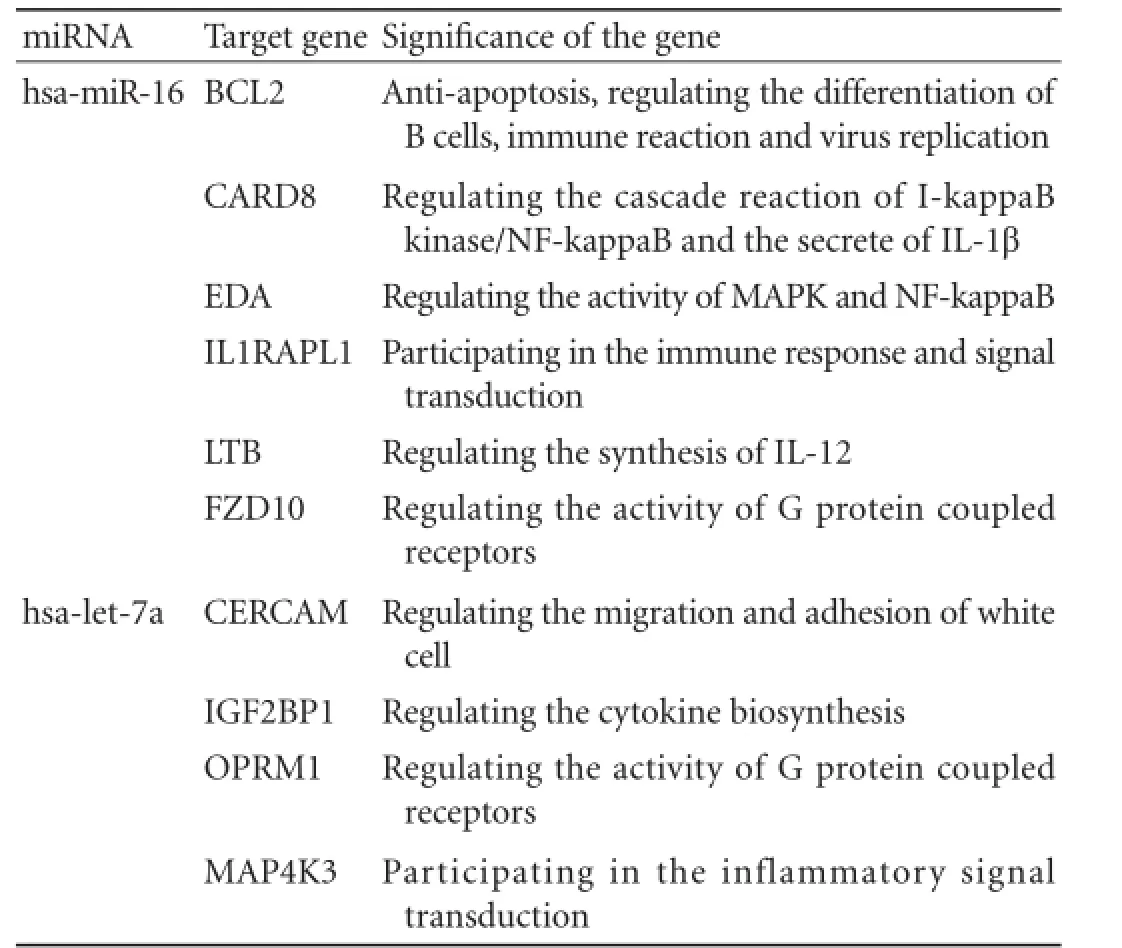
Table 3.The putative target genes and significance
Discussion
miRNAs play a crucial role in the pathophysiology of various diseases, including viral infection and its related diseases.[32]Using a genome-wide miRNA microarray analysis, we screened and analyzed miRNAs from the PBMCs of ACLF patients and AsCs. This is the first study to investigate the PBMC miRNA profile in ACLF patients. We identified 53 differentially expressed miRNAs in PBMCs, of which 45 miRNAs were upregulated and 8 miRNAs down-regulated in ACLF patients. We also found that the expressions of two miRNAs (hsa-let-7a and hsa-miR-16) were significantly up-regulated in ACLF patients compared to AsCs. Our results showed that there was a relationship between specific miRNAs of PBMCs and ACLF. Some specific miRNAs, such hsa-let-7a as and hsa-miR-16, may contribute to the development of ACLF.
Microarray chip is commonly used for screening the miRNAs expression profile in serum or tissues. However, the previous results of microarray chip were unavoidably influenced by bias from individual difference since microarray analysis was usually made using the intersection pool of different samples. To decrease the bias from individual difference, the analysis of our microarray chips was made using the monozygotic twin samples with distinct phenotypes. Because twins share similar genetics and rearing-environment, they are the best subjects for genetic studies including investigation of environmental and genetic contributions to human diseases. The present study is the first one to use the samples of twins to screen the PBMC miRNA profile in ACLF patients. In addition, we used the strict criteria for selecting the aberrant expression miRNAs in ACLF patients. The criteria were rigorous and ensured the credibility of the results after the application of microarray chips. We also found differential expression of miRNAs which had the same expression in different chips and confirmed their reliability by qRT-PCR in extended samples. To assess microarray results, we first analyzed qRT-PCR expression in the samples of twins, and then confirmed the microarray results in a large hospital-based case-control cohort including 104 ACLF patients and 96 AsC controls. In the present study, we found that the expression levels of miRNA hsa-let-7a and hsa-miR-16 were significantly up-regulated in ACLF patients as compared with AsC carriers. These repetitive and reliable results suggested that miRNA hsa-let-7a and hsa-miR-16 might be used as biomarkers for the diagnosis and prognosis of ACLF.
As endogenous physiological regulators of gene expression, miRNAs may regulated gene expression by repression of translation/transcription[33]or modulated gene expression by activation of transcription.[34]Furthermore, a single miRNA can interact with multiple target genes, by direct or indirect effects, and control the production of multiple proteins.[35]Thus, the prediction of the putative target genes and functional analysis of the miRNAs, hsa-let-7a and hsa-miR-16, may offer new insight into the basic study in pathology of ACLF. In our study, we predicted the potential targets by monitoring genome-wide mRNA expression used different algorithms, i.e, PicTar, TargetScan and Diana microT. The comprehensive application of multiple prediction methods can make our prediction results more targeted and rigor.[27, 36]
Our analysis suggested that CARD8, BCL2, IL1RAPL1, LTB, FZD10 and EDA genes may be the putative target genes of the miRNA hsa-miR-16, while MAP4K3, OPRM1, IGF2BP1 and CERCAM genes may be the putative target genes of the miRNA hsa-let-7a. All of these putative target genes function as important molecules involved in the hepatic inflammation, metabolism and immunology and play key roles in the pathophysiology of ACLF. Some of these putative target genes have been verified by previous studies. It was reported that miR-16 and miR-15 are natural antisenses of BCL2 interactors and that BCL2 repression regulated by the miRNAs induces apoptosis from leukemic cells.[37]CARD protein was reported to play important roles in the modulation of NF-kappaB and caspase activation.[38]LTB is known as a potent mediator ofinflammation and that LTB repression by miRNAs may reduce the release of IL-10 and IL-12 p40 in dendritic cells.[39]EDA-containing cellular fibronectin may lead to fibroblast differentiation by binding to MAPK/ Erk 1/2-dependent signaling and integrin receptor alpha4beta7.[40]Given the importance of these putative target genes in the pathophysiology of apoptosis and inflammation, these putative target genes might involve in the pathophysiology of ACLF. Further studies are needed to clarify the mechanism that how these miRNAs interact with the putative target genes in the development of ACLF.
In conclusion, there is a relationship between specific miRNAs of PBMCs and ACLF. Some specific miRNAs, hsa-let-7a and hsa-miR-16, may contribute to the development of ACLF. These findings help to understand the immune pathology of ACLF. Further studies are required to elucidate the roles of miRNAs gene regulation in the pathogenesis of ACLF.
Acknowledgement:The authors thank the patients who participated in this study.
Contributors:WYM designed the research; CW and YZH performed the research and wrote the first draft; YZH, XBY and DGH analyzed the data; WYM and DGH reviewed and revised the paper. All authors contributed to the design and interpretation of the study and to further drafts. WYM is the guarantor.
Funding:This work was supported in part by the National Natural Science Foundation of China (81100290 and 30972598), the State Key Project Specialized for Infectious Diseases (2012ZX10002-004), the Chongqing Natural Science Foundation (CSTC-2008BB5129 and CSTC-2010BB5037), and the TMMU Key Project for Clinical Research (2012XLC-005).
Ethical approval:This study was approved by the Ethical Committee of Southwest Hospital, Chongqing, China.
Competing interest:No benefits in any form have been received or will be received from a commercial party related directly or indirectly to the subject of this article.
1 Liaw YF, Chu CM. Hepatitis B virus infection. Lancet 2009; 373:582-592
2 Ganem D, Prince AM. Hepatitis B virus infection--natural history and clinical consequences. N Engl J Med 2004;350: 1118-1129.
3 Binns C, Boldy D. The burden of disease in the Asia-Pacific region--challenges to public health. Asia Pac J Public Health 2003;15:77-78.
4 Wai CT, Fontana RJ. Clinical significance of hepatitis B virus genotypes, variants, and mutants. Clin Liver Dis 2004;8:321- 352.
5 Chisari FV, Ferrari C. Hepatitis B virus immunopathogenesis. Annu Rev Immunol 1995;13:29-60.
6 Guidotti LG, Chisari FV. Noncytolytic control of viral infections by the innate and adaptive immune response. Annu Rev Immunol 2001;19:65-91.
7 Kloosterman WP, Plasterk RH. The diverse functions of microRNAs in animal development and disease. Dev Cell 2006;11:441-450.
8 Zhao Y, Srivastava D. A developmental view of microRNA function. Trends Biochem Sci 2007;32:189-197.
9 Lecellier CH, Dunoyer P, Arar K, Lehmann-Che J, Eyquem S, Himber C, et al. A cellular microRNA mediates antiviral defense in human cells. Science 2005;308:557-560.
10 Cullen BR. Viruses and microRNAs: RISCy interactions with serious consequences. Genes Dev 2011;25:1881-1894.
11 Zhang X, Zhang E, Ma Z, Pei R, Jiang M, Schlaak JF, et al. Modulation of hepatitis B virus replication and hepatocyte differentiation by MicroRNA-1. Hepatology 2011;53:1476-1485.
12 Guo H, Liu H, Mitchelson K, Rao H, Luo M, Xie L, et al. MicroRNAs-372/373 promote the expression of hepatitis B virus through the targeting of nuclear factor I/B. Hepatology 2011;54:808-819.
13 Li C, Wang Y, Wang S, Wu B, Hao J, Fan H, et al. Hepatitis B virus mRNA-mediated miR-122 inhibition upregulates PTTG1-binding protein, which promotes hepatocellular carcinoma tumor growth and cell invasion. J Virol 2013;87: 2193-2205.
14 Wang S, Qiu L, Yan X, Jin W, Wang Y, Chen L, et al. Loss of microRNA 122 expression in patients with hepatitis B enhances hepatitis B virus replication through cyclin G(1)-modulated P53 activity. Hepatology 2012;55:730-741.
15 Waidmann O, Bihrer V, Pleli T, Farnik H, Berger A, Zeuzem S, et al. Serum microRNA-122 levels in different groups of patients with chronic hepatitis B virus infection. J Viral Hepat 2012;19:e58-65.
16 Qi P, Cheng SQ, Wang H, Li N, Chen YF, Gao CF. Serum microRNAs as biomarkers for hepatocellular carcinoma in Chinese patients with chronic hepatitis B virus infection. PLoS One 2011;6:e28486.
17 Li LM, Hu ZB, Zhou ZX, Chen X, Liu FY, Zhang JF, et al. Serum microRNA profiles serve as novel biomarkers for HBV infection and diagnosis of HBV-positive hepatocarcinoma. Cancer Res 2010;70:9798-9807.
18 Arataki K, Hayes CN, Akamatsu S, Akiyama R, Abe H, Tsuge M, et al. Circulating microRNA-22 correlates with microRNA-122 and represents viral replication and liver injury in patients with chronic hepatitis B. J Med Virol 2013;85:789-798.
19 Xiao C, Rajewsky K. MicroRNA control in the immune system: basic principles. Cell 2009;136:26-36.
20 O'Connell RM, Rao DS, Chaudhuri AA, Baltimore D. Physiological and pathological roles for microRNAs in the immune system. Nat Rev Immunol 2010;10:111-122.
21 Winther TN, Bang-Berthelsen CH, Heiberg IL, Pociot F, Hogh B. Differential plasma microRNA profiles in HBeAg positive and HBeAg negative children with chronic hepatitis B. PLoS One 2013;8:e58236.
22 Mitchell PS, Parkin RK, Kroh EM, Fritz BR, Wyman SK, Pogosova-Agadjanyan EL, et al. Circulating microRNAs as stable blood-based markers for cancer detection. Proc Natl Acad Sci U S A 2008;105:10513-10518.
23 Zhu HT, Dong QZ, Sheng YY, Wei JW, Wang G, Zhou HJ, et al. MicroRNA-29a-5p is a novel predictor for early recurrence of hepatitis B virus-related hepatocellular carcinoma after surgical resection. PLoS One 2012;7:e52393.
24 Elmén J, Lindow M, Schütz S, Lawrence M, Petri A, Obad S, et al. LNA-mediated microRNA silencing in non-human primates. Nature 2008;452:896-899.
25 Esteller M. Non-coding RNAs in human disease. Nat Rev Genet 2011;12:861-874.
26 Janssen HL, Reesink HW, Lawitz EJ, Zeuzem S, Rodriguez-Torres M, Patel K, et al. Treatment of HCV infection by targeting microRNA. N Engl J Med 2013;368:1685-1694.
27 Mendes ND, Freitas AT, Sagot MF. Current tools for the identification of miRNA genes and their targets. Nucleic Acids Res 2009;37:2419-2433.
28 Xu BY, Wang YM, Deng GH, Huang YP, Zhong LH, Liu GD, et al. The primary comparative analysis between the host genetic factors and their relationships with clinical phenotype of HBV infected twins. Zhonghua Yi Xue Za Zhi 2004;84:189-193.
29 Liver Failure, Artificial Liver Group CSoIDCMA, Severe Liver Disease and Artificial Liver Group CSoHCMA. Guideline for diagnosis and treatment of liver failure. Chin J Clin Infect Dis 2012;5:321-327.
30 Yan Z, Tan W, Zhao W, Dan Y, Wang X, Mao Q, et al. Regulatory polymorphisms in the IL-10 gene promoter and HBV-related acute liver failure in the Chinese population. J Viral Hepat 2009;16:775-783.
31 Livak KJ, Schmittgen TD. Analysis of relative gene expression data using real-time quantitative PCR and the 2(-Delta Delta C(T)) Method. Methods 2001;25:402-408.
32 Ura S, Honda M, Yamashita T, Ueda T, Takatori H, Nishino R, et al. Differential microRNA expression between hepatitis B and hepatitis C leading disease progression to hepatocellular carcinoma. Hepatology 2009;49:1098-1112.
33 Bartel DP. MicroRNAs: target recognition and regulatory functions. Cell 2009;136:215-233.
34 Li LC. The multifaceted small RNAs. RNA Biol 2008;5:61-64.
35 Selbach M, Schwanh?usser B, Thierfelder N, Fang Z, Khanin R, Rajewsky N. Widespread changes in protein synthesis induced by microRNAs. Nature 2008;455:58-63.
36 Yan X, Chao T, Tu K, Zhang Y, Xie L, Gong Y, et al. Improving the prediction of human microRNA target genes by using ensemble algorithm. FEBS Lett 2007;581:1587-1593.
37 Cimmino A, Calin GA, Fabbri M, Iorio MV, Ferracin M, Shimizu M, et al. miR-15 and miR-16 induce apoptosis by targeting BCL2. Proc Natl Acad Sci U S A 2005;102:13944- 13949.
38 Chang MX, Chen WQ, Nie P. Structure and expression pattern of teleost caspase recruitment domain (CARD) containing proteins that are potentially involved in NF-kappaB signalling. Dev Comp Immunol 2010;34:1-13.
39 Jozefowski S, Biedroń R, Bobek M, Marcinkiewicz J. Leukotrienes modulate cytokine release from dendritic cells. Immunology 2005;116:418-428.
40 Kohan M, Muro AF, White ES, Berkman N. EDA-containing cellular fibronectin induces fibroblast differentiation through binding to alpha4beta7 integrin receptor and MAPK/Erk 1/2-dependent signaling. FASEB J 2010;24:4503-4512
Received June 14, 2013
Accepted after revision September 23, 2013
Author Affiliations: Institute of Infectious Diseases, Southwest Hospital, Third Military Medical University, Chongqing 400038, China (Chen W, Yan ZH, Wang YM, Xu BY and Deng GH); Chongqing Key Laboratory for Research of Infectious Diseases, Chongqing 400038, China (Yan ZH, Wang YM, Xu BY and Deng GH)
Professor Yu-Ming Wang, Institute of Infectious Diseases, Southwest Hospital, Third Military Medical University, Chongqing 400038, China (Tel: 86-23-68754858; Fax: 86-23-65334998; Email: wym417@ 163.com)
? 2014, Hepatobiliary Pancreat Dis Int. All rights reserved.
10.1016/S1499-3872(14)60004-7
 Hepatobiliary & Pancreatic Diseases International2014年1期
Hepatobiliary & Pancreatic Diseases International2014年1期
- Hepatobiliary & Pancreatic Diseases International的其它文章
- Samaritan donor interchange in living donor liver transplantation
- ZBTB20 is involved in liver regeneration after partial hepatectomy in mouse
- Graft cholangiopathy: etiology, diagnosis, and therapeutic strategies
- Hepatobiliary & Pancreatic Diseases International (HBPD INT)
- Graft-to-recipient weight ratio lower to 0.7% is safe without portal pressure modulation in right-lobe living donor liver transplantation with favorable conditions
- Platelet count reduction and outcomes in living liver donors
